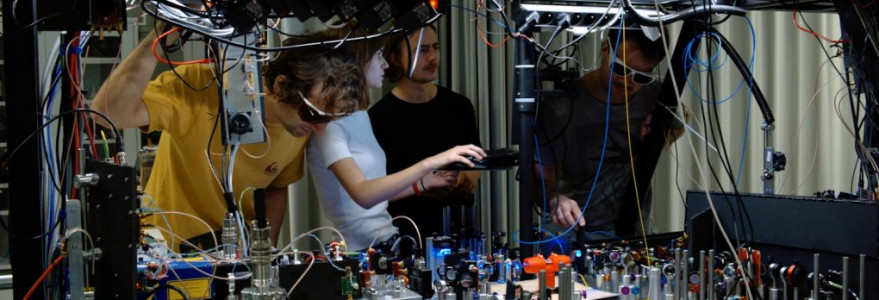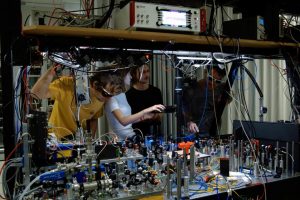Researchers from the University of Warsaw made a device, which may enable network interface for quantum computers. The research findings were published in the Nature Photonics journal.
A team of UW researchers made a device capable of the conversion of quantum information between microwave and optical photons. The research was conducted at the (QOT) Centre for Quantum Optical Technologies by Prof. Michał Parniak, Dr Mateusz Mazelanik, Sebastian Borówka, a doctoral candidate, and Uliana Pylypenko, a Master student from the Faculty of Physics.
The research results, published in Nature Photonics, highlight a new microwave detection method with possible applications in quantum technologies, as part of quantum network infrastructure, and in microwave radio-astronomy.
Conversion of quantum information
Whenever one listens to a song on a phone or computer, a conversion of information happens – a file digitally encoded in one’s device’s memory is converted to an electric current driving the headphones.
“Similarly, we can convert quantum information encoded in photons – the smallest quanta of light. For example, we can transfer information from a single microwave photon to a single optical photon. However, devices capable of single-photon operations are quite difficult to realise, because they need to be very precise and introduce very little noise,” says a team leader, Prof. Michał Parniak from the Centre of New Technologies, the University of Warsaw. “What makes the task challenging is the fact that optical photons have energy ten thousand times larger than microwave photons and there are few media capable of simultaneously interacting with both species,” adds the researcher.
The conversion of quantum information is pivotal to hybrid quantum networks – networks connecting different quantum devices, such as quantum computers. Quantum computing can be realised with microwave photons interacting with superconducting circuits.
“The long-distance transfer of quantum information encoded in this manner poses a challenge due to the accumulation of noise. However, this is no longer a problem for optical photons, which can efficiently send quantum information via optical fibers. Therefore, the microwave-to-optical converter of quantum information can be a crucial part of a quantum network adapter – an interface between quantum computers and the quantum internet,” Dr Mateusz Mazelanik from the UW’s Centre of New Technologies explains.
Enlarged atoms
One known medium that can interact both with microwave and optical photons are Rydberg atoms. They can be produced via laser excitation of valence electrons e.g. in rubidium atoms. So far, microwave-to-optical conversion has only been demonstrated in laser-cooled atoms caught in complex magneto-optical trapping setup.
“We are the first to show that microwave-to-optical conversion can be undertaken at room temperature, in atomic vapours inside a glass cell, Prof. Michał Parniak emphasises. “The proposed design of the converter is notably simpler and can be further miniaturised in the future. Additionally, the new conversion scheme shows very low noise levels and therefore can perform operations even on single photons,” he adds.
Using the converter device, UW scientists have demonstrated the detection of microwave thermal radiation at room temperature – for the first time it has been done without using microwave antennas or special low-noise amplifiers.
“To get to the thermal level, the device has to be sensitive to single photons. Nevertheless, the converter can work for microwave radiation a million times stronger and cannot be damaged with even stronger fields, in contrast to other standard microwave devices,” Dr Mateusz Mazelanik explains.
“Even though the new converter setup is much simpler, the parameters of the conversion are surprisingly better. Our invention can work non-stop, as the atoms do not have to be prepared in a specially designed time sequence, which can take up more than 99% of the devices’ operational time in experiments done by other groups,” Prof. Parniak adds.
The future lies in microwaves
The rapidly developing quantum technologies use various information carriers. Quantum computers based on superconducting junctions store their information in microwave frequencies, whereas quantum memories are largely based on optical photons. Similarly to the quantum network adapter, the interconnection between the two types of devices requires an interface that can efficiently work both in microwave and optical domain. Rydberg atoms are being presented here as the solution.
Currently, there is ongoing research in the (QOT) Centre for Quantum Optical Technologies, as well as in scientific institutes all over the world, on how to employ quantum technologies in ultrasensitive microwave detection.




